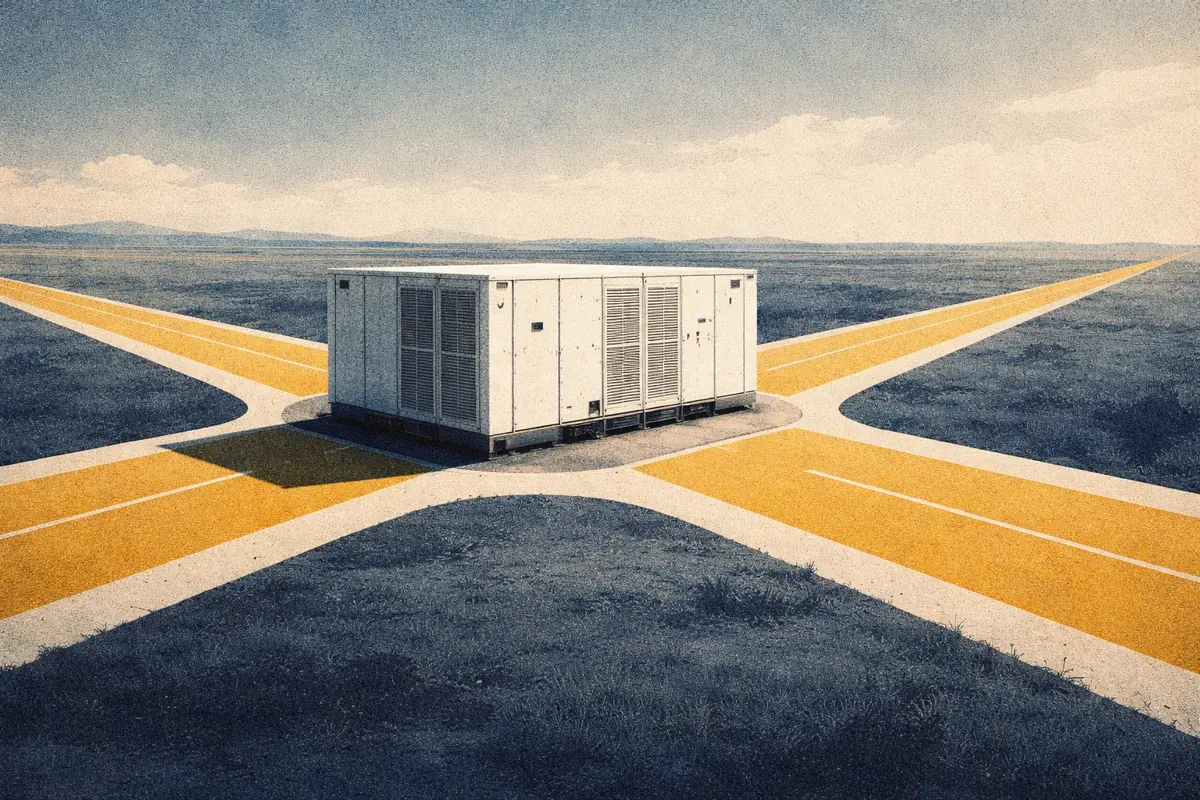Co-location of battery energy storage: AC/DC coupling
Co-location of storage does not have a one-size-fits-all solution. Many technical solutions exist, all of which change the operational constraints and commercial opportunities of a project. So, just how do you go about co-locating a battery energy storage system with generation?
In our previous piece on co-location, we introduced the concept of co-locating battery energy storage alongside sources of generation. In this piece, we dig into the details of how exactly to set up a co-located site. The focus of this piece is on co-located solar and storage, although certain aspects apply to any type of co-location.
Spoiler Alert
- AC coupling is the most common method to co-locate projects. This means the storage is connected to generation on the AC side of the battery inverter, before reaching the grid connection.
- DC coupling is an alternative option for solar and storage projects. The battery connects to the solar on the DC side of both assets. The two assets then share a single inverter.
- Either solution introduces constraints in the operation of the battery energy storage asset. This is because a shared grid connection does not (usually) have room for full export from both battery and generation assets at the same time.
- Metering can significantly change the operation of a project, by grouping or separating the battery and the generation source.
Sharing (a grid connection) is caring
The most common route for the co-location of storage and solar to date has been through AC coupling. The two assets are coupled together on the alternating current (AC) side of their inverters - before the power reaches the grid connection.
Battery energy storage either charges or discharges electricity in direct current (DC). This is also how a lot of renewable generation works - including solar. This power signal must be converted into AC before exporting to the grid. This is the role of an inverter.
To explain co-location solutions in more detail, we will use a hypothetical solar and storage project, located at Modo HQ in sunny Birmingham. This has the following specifications:
- A 50 MW grid connection (import and export).
- A 50 MWh battery with a 50 MW inverter.
- A 70 MWp solar farm with a 50 MW inverter.
Jargon buster: 70MWp solar means the solar panels produce 70MW at the DC side of the inverter at peak production.
So what would our AC-coupled site look like?
Figure 1 (below) shows example configurations of these three components. An AC-coupled solar and storage site is compared to two separate stand-alone sites.

- In the first example, two stand-alone projects exist, one battery energy storage and one solar. Each has its own grid connections.
- The second example has the two assets connecting before reaching the grid connection. This saves on the costs of connecting to the grid.
- In both projects, the inverter clips the total DC generation of the solar panels. Clipping means that the solar, at peak, produces more power than the inverter can convert. Excess power is lost as heat. It is common to oversize the DC capacity of a solar farm as compared to the inverter, as it results in a wider export shape - and so a higher load factor - and better returns.
- The inverter clips the solar generation before the battery energy storage connects. Because of this, the battery is unable to charge from this ‘excess’ solar.
Co-location introduces constraints
The co-location of the two assets introduces a constraint on the export capability of the site. When the solar is generating and exporting through a single connection, the remaining export capacity available to the battery reduces.
This constraint means that both the battery and the solar cannot export to their full capability at the same time. As the more flexible asset, it is most common to alter the operation of the battery around this constraint.
Figure 2 (below) shows how solar production limits the export capacity available to the battery.

- Overnight, the battery energy storage system has the availability to export at its full power, as the solar is not generating and so the grid connection has 50MW of headroom.
- At midday, the solar is exporting at full power and there is no headroom available for the battery to export at all.
- This introduces constraints in the operation of the battery and how it can bid for ancillary services.
- The inverter caps the unclipped solar generation profile at 50MW. The system also loses power through the inverter due to conversion losses.
How does this work in practice?
To ensure the safe operation of a co-located AC-coupled site, it needs export-limiting hardware and software. In our example, the total export capability between the solar and battery (100 MW) exceeds the available grid capacity (50MW). Exceeding the grid connection capacity can result in a Distribution Network Operator-mandated trip. Grid connection agreements often stipulate that the site will trip if the limits are exceeded. This is via the G99 certification which mandates the site can connect to the local network.
This has associated costs - both in lost export for the duration of the trip and penalties from the Distribution Network Operator. So, the on-site solution that ensures the import and export limits of a site are not exceeded must be robust to protect against this.
DC-coupling: the holy grail of co-location?
The section above covers the method of AC coupling. However, another solution for solar and storage projects exists called DC coupling. In a DC-coupled solar and storage site, the coupling of the two assets is shifted behind a single inverter.
Figure 3 (below) shows how this would work for our hypothetical solar and storage project.

- This is the most efficient solution possible from a technology perspective, with a single shared inverter and grid connection.
- The battery is now coupled with the solar behind the inverter. This means it can charge directly from the solar, including generation that would otherwise be clipped.
- The DC-coupled site has the same constraint as the AC-coupled site. However, this is now at the inverter rather than the grid connection. This makes it impossible to physically output more than the grid export capacity.
- This also means DC-coupling can be the preferred option from the network operator’s perspective and in some regions could be prioritized for connection.
So, what’s the catch?
DC coupling is frequently described as the optimal solution for the co-location of solar and storage, for the reasons outlined above. However, most announced solar and storage projects in the UK to date are AC-coupled. Why?
- While the sharing of the inverter should reduce costs, pricing efficiencies in storage have been driven by the advancement of all-in-one storage solutions (often called ‘containerized solutions’). Unraveling this can negate these cost benefits.
- The power output of the inverter is the combination of both solar and battery power signals - which includes the noise seen in solar generation profiles. This can impact the ability of the project to provide ancillary services currently metered on the AC side of the inverter, such as frequency response.
- Finally, coupling behind the inverter further integrates the solar and storage assets. This limits the ability to commercially separate the two assets, restricting some financing routes available to AC-coupled projects.
Psst... we’d love your feedback! 🙏
You can now leave comments on Phase articles. So, if you've got a question you'd like answered or an opinion to share - you can let us know! We can’t wait to hear from you.







